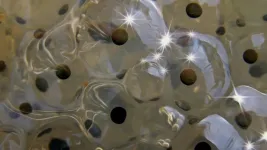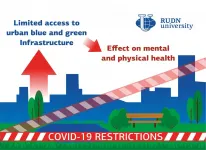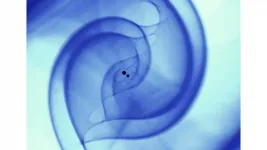More EVs could reduce CO2 emissions in Hawaii by 93% in less than 30 years
2021-07-07
(Press-News.org) By 2050, faster adoption of electric vehicles (EVs) and faster generation of renewable energy will result in 99% less fossil fuel consumed and 93% less CO2 emissions from passenger and freight vehicles on O?ahu. That's under the most ambitious scenario in an article published in World Electric Vehicle Journal, by University of Hawai?i at Mānoa School of Ocean and Earth Science and Technology (SOEST) faculty member Katherine McKenzie.
McKenzie, based at the Hawai?i Natural Energy Institute in SOEST, created mathematical models of four scenarios based on projections for the switch to electric passenger and freight vehicles, and renewable power generation. She quantified the impacts of fossil fuel use and CO2 emissions on O?ahu and found that scenarios with a slower transition to EVs result in billions more gallons of gasoline consumed, and tens of millions more tons of CO2 emitted.
As with many other remote communities still dependent on oil for both transportation and power, there remains a lack of critical analysis to determine the benefits of transitioning from internal combustion engine vehicles to plug-in electric vehicles (EVs). In 2020, average passenger EVs were found to consume the equivalent of 66 gallons of gasoline, seven times less fossil fuel than their gasoline-powered counterparts, which used 455 gallons. Average EVs also cut emissions in half, two metric tons of CO2 versus four metric tons of CO2.
"Continuing to purchase anything powered by petroleum locks in emissions and energy insecurity for years to come, at a time when decarbonization is a climate imperative," said McKenzie. "A shift is needed to energy efficient modes of travel--such as bicycling, walking and transit, along with reducing vehicle miles traveled (by "smart" city planning and remote work for example)."
INFORMATION:
[Attachments] See images for this press release:

ELSE PRESS RELEASES FROM THIS DATE:
2021-07-07
Five years ago, researchers at Northwestern University made international headlines when they discovered that human eggs, when fertilized by sperm, release billions of zinc ions, dubbed "zinc sparks."
Now, Northwestern has teamed up with the U.S. Department of Energy's (DOE) Argonne National Laboratory and Michigan State University (MSU) to reveal that these same sparks fly from highly specialized metal-loaded compartments at the egg surface when frog eggs are fertilized. This means that the early chemistry of conception has evolutionary roots going back at least 300 million years, to the last common ancestor between frogs and people.
"This work may help inform our understanding of the interplay of dietary zinc status and human fertility." -- Thomas O'Halloran, professor, Michigan State ...
2021-07-07
The measures taken during the COVID-19 pandemic limited the access of citizens to natural objects. It is still unexplored, what consequences this had for the residents and what conclusions should be drawn for more effective urban planning. RUDN University scientists with colleagues from Australia and Germany studied how the restrictions associated with COVID-19 affected the use of blue and green infrastructure by citizens in Moscow (Russia) and Perth (Australia), and what consequences this had for their health. In the article "Human Dimensions of Urban Blue and Green Infrastructure during a Pandemic. The Case Study of Moscow (Russia) ...
2021-07-07
Bahamian mosquitofish in habitats fragmented by human activity are more willing to explore their environment, more stressed by change and have smaller brain regions associated with fear response than mosquitofish from unaffected habitats. The new study from North Carolina State University shows that these fish have adapted quickly in specific ways to human-driven change, and cautions that environmental restoration projects should understand these changes so as not to damage adapted populations.
The Bahamas mosquitofish is a small, coastal fish species that frequently inhabits tidal creeks - shallow, tidally influenced marine ecosystems. ...
2021-07-07
In 2019, Anaïs Llorens and Athina Tzovara -- one a current, the other a former University of California, Berkeley, postdoctoral scholar at the Helen Wills Neuroscience Institute (HWNI) -- were attending a scientific meeting and pleased that one session, on gender bias in academia, attracted nearly a full house. The problem: The audience of some 300 was almost all women.
Where were the men, they wondered? More than 75% of all tenured faculty in Ph.D. programs around the world are men, making their participation key to solving the problem of gender bias, which negatively impacts the careers, work-life balance and mental health of all women in science, and even more ...
2021-07-07
FOR IMMEDIATE RELEASE
In what turned out to be one of the most important accidents of all time, Scottish bacteriologist Alexander Fleming returned to his laboratory after a vacation in 1928 to find a clear zone surrounding a piece of mold that had infiltrated a petri dish full of Staphylococcus aureus (S. aureus), a common skin bacterium he was growing.
That region of no bacterial growth was the unplanned birth of a medical miracle, penicillin, and would lead to the era of antibiotics. Now, END ...
2021-07-07
When gravitational waves were first detected in 2015 by the advanced Laser Interferometer Gravitational-Wave Observatory (LIGO), they sent a ripple through the scientific community, as they confirmed another of Einstein's theories and marked the birth of gravitational wave astronomy. Five years later, numerous gravitational wave sources have been detected, including the first observation of two colliding neutron stars in gravitational and electromagnetic waves.
As LIGO and its international partners continue to upgrade their detectors' sensitivity to gravitational waves, they will be able to probe a larger volume of the universe, thereby making the detection ...
2021-07-07
As the COVID-19 pandemic wanes in the U.S., a new study from the University of Maryland School of Medicine (UMSOM) and University of Maryland Medical Center (UMMC) finds that hospitals nationwide may not be adequately prepared for the next pandemic. A 10-year analysis of hospitals' preparedness for pandemics and other mass casualty events found only marginal improvements in a measurement to assess preparedness during the years leading up to the COVID-19 pandemic. The study was published last month in the Journal of Healthcare Management.
"Our work links objective healthcare data to a hospital score that ...
2021-07-07
If a virtual world has ever left you feeling nauseous or disorientated, you're familiar with cybersickness, and you're hardly alone. The intensity of virtual reality (VR)--whether that's standing on the edge of a waterfall in Yosemite or engaging in tank combat with your friends--creates a stomach-churning challenge for 30-80% of users.
In a first-of-its kind study, researchers at the University of Maryland recorded VR users' brain activity using electroencephalography (EEG) to better understand and work toward solutions to prevent cybersickness. The research was conducted by Eric Krokos, who received his Ph.D. in computer science in 2018, and Amitabh Varshney, a professor of computer science ...
2021-07-07
Although wastewater disposal has been the primary driving force behind increased earthquake activity in southern Kansas since 2013, a new study concludes that the disposal has not significantly changed the orientation of stress in the Earth's crust in the region.
Activities like wastewater disposal can alter pore pressure, shape and size within rock layers, in ways that cause nearby faults to fail during an earthquake. These effects are thought to be behind most recent induced earthquakes in the central and eastern United States.
It is possible, however, that human activity could also lead to earthquakes by altering the orientation of stresses that act on faults in the region, said U.S. Geological Survey seismologist ...
2021-07-07
As more evidence emerges that opioid overdose deaths have increased dramatically since the onset of COVID-19, the Centre for Addiction and Mental Health (CAMH), in collaboration with subject matter experts and medical regulatory authorities across Canada, have now released updated national clinical guidelines for the treatment of opioid use disorder. END ...
LAST 30 PRESS RELEASES:
[Press-News.org] More EVs could reduce CO2 emissions in Hawaii by 93% in less than 30 years





